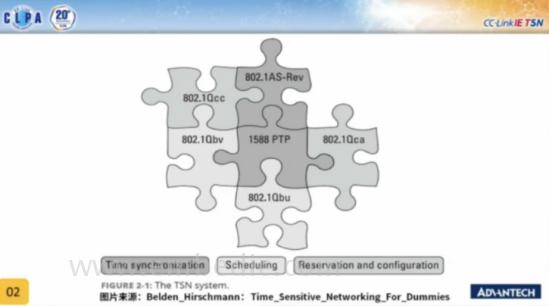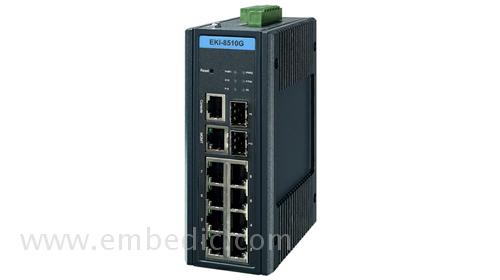With the development of the Industrial Internet of Things, different scenarios and applications have different requirements for data transmission. Network deployment is facing new requirements and challenges. In order to effectively solve the uncertain problems of Ethernet communication and realize real real-time communication, various Manufacturers began to vigorously introduce and promote Time Sensitive Network (TSN).

TSN has many functions that are difficult to implement in traditional industrial network architecture. What is its past and present? What opportunities can TSN bring to the deep integration of IT and OT? What are the latest industry trends? Recently, Advantech and CC-Link Association held an online conference in the form of cross-strait live streaming. We might as well use this conference to gain insight into TSN, an industrial network technology that may become a unified standard for industrial communications in the future.
Industrial Ethernet is not a new concept, dozens of communication protocols were born during its vigorous development. Zhang Yicheng, senior development manager of Advantech Industrial Internet of Things business group, said that the communication protocols currently used in the industrial field are of different types, and each protocol has its own supporting vendors. Although they have their own advantages in isolation, the biggest problem is It is incompatible with each other and it is difficult to form a unified standard. The “language” barrier brings great difficulty to real-time communication. If you want to enjoy the convenience of “the same text in the book and the same track in the car”, a unified standard TSN has emerged.
Traditional industrial networks have problems of delay and difficulty in real-time control. The transmission speed cannot exceed 100 Mb/s, and the scalability is therefore affected. Different communication protocols can only use proprietary hardware and software, which severely restricts user flexibility, equipment interoperability, and increases maintenance and operating costs. The four experts participating in this conference agreed that in the age of industrial Internet, enterprises urgently need to maintain agility and flexibility to the greatest extent in order to improve efficiency and rapid response capabilities. The emergence of TSN is solving this problem.
Yang Kai, a senior engineer of CLPA China branch, said that in the current factory network, different production lines may have different bus protocols such as Profinet and CC-Link. The data exchange and information transformation between different production lines are always Pain points for users. The traditional industrial real-time Ethernet generally adopts the method of reserved bandwidth to ensure the real-time performance and accuracy of data, but the reliability and real-time performance are really mediocre. As a protocol standard for Ethernet expansion, TSN has shown unprecedented potential in realizing data fusion transmission, breaking information islands, and realizing interconnection.
TSN was originally a standardized specification that originated from Ethernet AVB (Audio Video Bridging). After it was given functions such as time synchronization, control of A/V machine functions, and bandwidth reservation, it was continuously updated by the IEEE (Institute of Electrical and Electronics Engineers). , Popularized in industries such as industry and automobile, and officially changed its name to TSN in 2012. Obviously, in the future, industrial Ethernet will migrate from individual specifications to common network specifications. Chen Chongguang, Director of CLPA China Taiwan Affairs, said that in recent years, in addition to the IEEE synchronizing the specifications to the IEC international standard specifications, the CC-Link Association, PI, OPC UA and other open network associations are also discussing TSN as an open Applicability of type network.
Chen Chongguang said that at present, the various subscribed specifications of TSN are still being formed, as technical specifications often used in industrial networks, of which IEEE802.1AS-Rev and 1588 PTP are used to define the synchronization time of connected machines on the network; IEEE802.1Qbv Classify communication frames to ensure priority communication bandwidth; IEEE802.1Qbu is responsible for defining priority communication frames. When entering the higher priority bandwidth, the communication frame will be divided and the higher priority priority will be passed. Chen Chongguang explained: "Under the existing network, the overall communication efficiency will be affected by the low-speed communication frame rate. When using TSN technology, it is like separating the fast and slow lanes on the highway, allowing specific communication protocols to pass through."

In response to users’ concerns about the use of TSN, Lin Yuwei, product director of Advantech’s Industrial Internet of Things business group, explained: “Convergence is not meant to replace. The original Ethernet protocols of all factories will still exist. TSN is just a unified standard to serve as these differences. The purpose of the medium of the agreement is to achieve the effect of integration."
Nowadays, if users want to move closer to the TSN standard, they not only need a gateway with TSN to convert between different protocols, but also a TSN switch to transmit and aggregate data. Chen Chongguang said: "Because of its timeliness, low latency, high-speed and large-capacity communication, TSN has multiple communication protocol functions such as time stamping, mixed IP communication, etc., its capabilities and advantages are more significant." This also allows relevant manufacturers to see it. Unlimited business opportunities.
In the development of TSN switches, Advantech has undoubtedly taken the lead. At this conference, Advantech officially released the EKI-8500G industrial-grade TSN Ethernet switch, which is currently one of the few TSN switches in the world that uses the TSN chip solution.

This new product is different from most of the TSN switches designed by FPGA (Field Programmable Gate Array) on the market. The EKI-8500G uses a TSN dedicated chip design, with 8 Gigabit RJ45 ports + 2 Gigabit SFP ports, and dual 12? 48 VDC power input and 1 x relay output. Lin Yuwei introduced in detail the four core features of EKI-8500G: time synchronization, priority traffic scheduling, time-aware shaper, and highly reliable redundant data transmission.
The so-called time synchronization (IEEE 802.1AS): In the traditional time synchronization communication architecture, the time sources between devices are different, and the requirements for timeliness are also different. TSN can make devices that are not synchronized in time share a precise time source. Such a synchronization mechanism can ensure the smooth operation of machines in fields such as semiconductor manufacturing and automobile manufacturing.
The so-called traffic scheduling function (IEEE 802.1Qbu): In the general communication architecture, when important OT data appears, it will not interrupt the data being transmitted, causing important messages to be delayed, resulting in downtime loss. TSN's priority traffic scheduling mechanism can interrupt the low-priority data currently being transmitted, allowing important data to go first, so that important information such as OT will not be preempted for transmission resources.
The so-called time-aware shaper (IEEE 802.1Qbv): The TSN standard sets up a time switch gate in the data note, so that real-time data can be transmitted within a fixed time without being affected by other non-real-time data. In simple terms, this mechanism is based on a known and set timetable for switching drive. Different from the QOS function of traditional switches, TSN switches will take advance and reserve methods for high-priority data to ensure real-time data circulation.
The so-called high-reliability redundant data transmission (IEEE 802.1CB): When data is being transmitted, the device will generate a duplicate backup file, and the two files will go on different transmission paths. If both of them arrive smoothly, The backup file will be automatically deleted. If one path is interrupted for some reason, the backup file of the other path will still reach the end point, ensuring that the data is delivered to the destination.
In addition to the above four major functions, in order to cope with industrial application scenarios, the new product has a smaller volume and can operate stably in the temperature range of -40 to 75°C. Lin Yuwei also added: "This product allows the information transmission environment to be In addition to the IT bandwidth, it has the accuracy and stability of OT." Advantech's EKI-8510G industrial switch brings high time efficiency, low latency, and stable and reliable operation to the IIoT industrial Internet of Things.
In addition to switch products in the future, Lin Yuwei also stated that Advantech will also have plans to launch more key TSN products such as switches, gateways, and configuration software. The audience interacted enthusiastically on the day of the conference. Some audiences asked questions online: "If the factory PLC and other equipment do not support TSN, how to solve the compatibility problem?"
Lin Yuwei explained: “TSN is a unified standard. If you want to support TSN between the equipment in the old factory, of course you need to use switches, gateways, and corresponding software. But take PLC as an example, as the main factory The technology matching degree of the controller has been at the forefront of the equipment. When the various Ethernet protocols of TSN were released, many PLC manufacturers smelled business opportunities and actively and vigorously promoted them. Once the factory’s PLC products go ahead, the surrounding The equipment of the product must also be kept in line. Therefore, the customer does not need to worry about the part of the product equipment, the manufacturer will help us solve it."
Of course, in addition to the active research and development of product suppliers, in order to actively embrace the TSN era, in February 2019, the CC-Link Association released a new communication protocol CC-Link IE TSN. This move expands CC-Link IE's advanced communication technology based on industrial Ethernet to realize vertical integration of enterprises from the information layer to the application layer. Yang Kai, a senior engineer of CLPA China branch, added: "Compared with traditional CC-Link and CC-Link IE, CC-Link IE TSN is unprecedented in terms of openness." The fully open architecture is also to facilitate more manufacturers to cooperate. , To jointly establish a TSN standard ecosystem.
It is reported that 56 CC-Link IE TSN intentional cooperation manufacturers including Mitsubishi have successively launched a full line of products from PLC, motion controller to switch, I/O, servo, robot and so on. In addition to CC-Link IE TSN, Modbus, Profinet, EtherNet/IP and other protocols have also been newly added to the TSN family. In addition, a number of TSN test beds have been set up around the world. The test beds are designed to accelerate the implementation of technology and help TSN in different industries, especially in transportation, 5G vertical market applications, automobiles, semiconductors and other fields. At this online conference, the four experts all showed their optimism towards the TSN ecosystem and believed that the Asian TSN ecosystem is expected to be established within 5 years.
In the field of industrial communication, it took about 10 years for the fieldbus technology to be introduced to the ground. The large-scale application of Ethernet technology took almost 5 years, and the emerging TSN is expected to mature in the next 3 to 5 years. For users or manufacturers, it only takes 1 to 2 years to develop products from project initiation to R&D mass production, and then to market. Yang Kai explained: "This is like the iteration of 3G, 4G, and 5G technologies. We can find that the life cycle of new technologies from launch to landing to maturity has been shortening."
In the past, the development and evolution of a new technology had to go through a series of small-scale or specific application trials, and then slowly spread to the entire industry. The TSN technology is different. It is like a newborn with a golden key. Because the industry is highly recognized, the development status of TSN we see today is the result of joint advancement by associations and alliances in many fields. In fact, the future of TSN technology has arrived. Regarding the development prospects of TSN, the guests analyzed that the industry is full of confidence. Zhang Yicheng said: "A large number of domestic manufacturers have invested in the research and development of TSN products, and TSN is expected to soon sweep the world."
In the future, industrial automation and control systems will strive to meet the needs of high availability and real-time communication. What is gratifying is that standards organizations and independent network protocol vendors have reached a consensus, have insight into the potential of this development trend, and work together to promote TSN, the next-generation industrial network standard. With the help of this shareholder style, free from the limitations of the existing exclusive structure, the grand cause of landing the industrial Internet of things and realizing the integration of IT and OT has taken another step forward. Let us look forward to the formation and growth of the TSN industry ecosystem. In the future, the cornerstone of emerging communication technology will be placed at the feet of every IOT world explorer.
Manufacturer: Microchip
IC MCU 8BIT 7KB FLASH 44TQFP
Product Categories: 8bit MCU
Lifecycle:
RoHS:
Manufacturer: Texas Instruments
IC DSP FLOATING POINT 256BGA
Product Categories: DSP
Lifecycle:
RoHS:
Manufacturer: Microchip
IC MCU 16BIT 32KB FLASH 28SDIP
Product Categories: 16bit MCU
Lifecycle:
RoHS:
Manufacturer: Texas Instruments
IC DIGITAL MEDIA SOC 529FCBGA
Product Categories: SOC
Lifecycle:
RoHS:
Looking forward to your comment
Comment